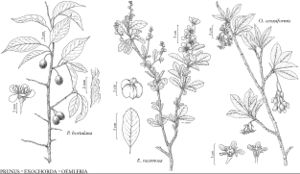Oemleria
Deut. Bot. Herb.-Buch, syn. red., 236. 1841.
| Taxon | Illustrator ⠉ | |
|---|---|---|
 | Prunus hortulana Exochorda racemosa Oemleria cerasiformis | Marjorie C. Leggitt Marjorie C. Leggitt Marjorie C. Leggitt |
Shrubs or trees, 15–60 dm. Stems (1–) 5–20, arching; bark purplish brown, pith chambered; long and short-shoots present; glabrous. Leaves deciduous, cauline, alternate; stipules caducous, free, distinct, linear, margins entire; petiole present; blade oblong-lanceolate, elliptic, or oblong, 5–10 (–15) cm, coriaceous, margins flat, entire, abaxial surface sometimes puberulent, glabrescent, adaxial glabrous. Inflorescences axillary on lateral, pendulous branches, 5–10-flowered, determinate racemes, glabrous, glabrate, or hairy; peduncles present; bracts present; bracteoles present. Pedicels present. Flowers usually unisexual, sometimes bisexual (plants usually dioecious, rarely monoecious), 10–15 mm diam.; hypanthium turbinate to campanulate, 3–5 mm, glabrous, glabrate, or hairy; sepals 5, spreading (staminate flowers) or erect (pistillate), triangular; petals 5, greenish white, elliptic-ovate or elliptic-obovate, base clawed; staminodia in pistillate flowers; stamens 15 in 3 series, shorter than petals; torus absent or minute; carpels usually 5 (not evident or aborted in staminate flowers), distinct, glabrous, styles 5, deciduous, included within hypanthia; stigmas 5, capitate; ovules 2. Fruits aggregated drupes, (1–) 2–5, purple-black, elliptic-obovate to ovate, 5–15 mm, pulp thin, glabrous; hypanthium persistent (staminate) or mostly deciduous (pistillate); sepals not persistent. Seeds 1. x = 8.
Distribution
w North America
Discussion
Species 1.
The relationship of Oemleria within Rosaceae has vacillated traditionally between Maloideae (Pyreae here) and Amygdaloideae (Amygdaleae here); recent work by R. C. Evans and T. A. Dickinson (1999) has suggested that its relationship is nearer Amygdaloideae. Even though Oemleria has five carpels per flower, a characteristic of Maloideae, Evans and Dickinson believed that its floral ontogeny and mature morphology support its inclusion in Amygdaloideae. They stated that they found the development of the gynoecium in Oemleria to be similar in some ways to that of Maloideae. Molecular phylogenetic studies (D. R. Morgan et al. 1994; S. Lee and J. Wen 2001; D. Potter et al. 2002) have recovered a well-supported clade of Exochorda, Oemleria, and Prinsepia Royle. Potter et al. (2007) have shown that this clade, Osmaronieae Rydberg, belongs to Amygdaloideae (as newly circumscribed) and is sister to Kerrieae, within a grade of tribes located between Amygdaleae and Pyreae.
Selected References
None.
Lower Taxa
"thin" is not a number.